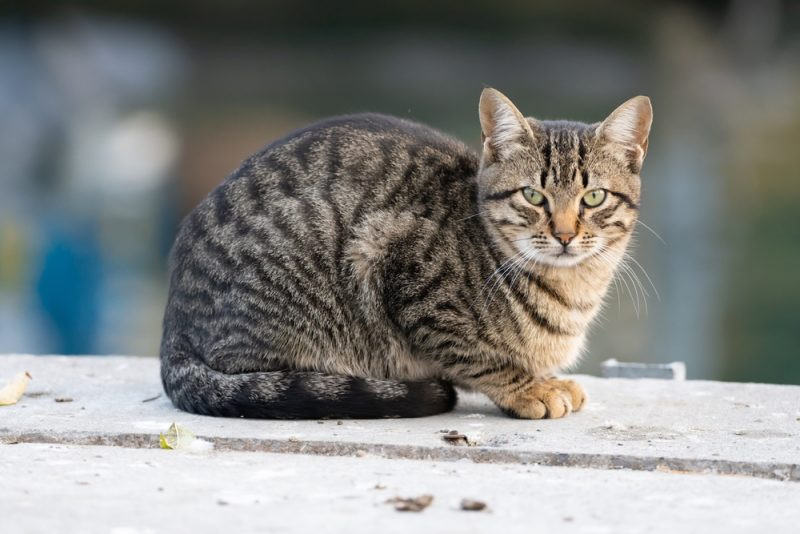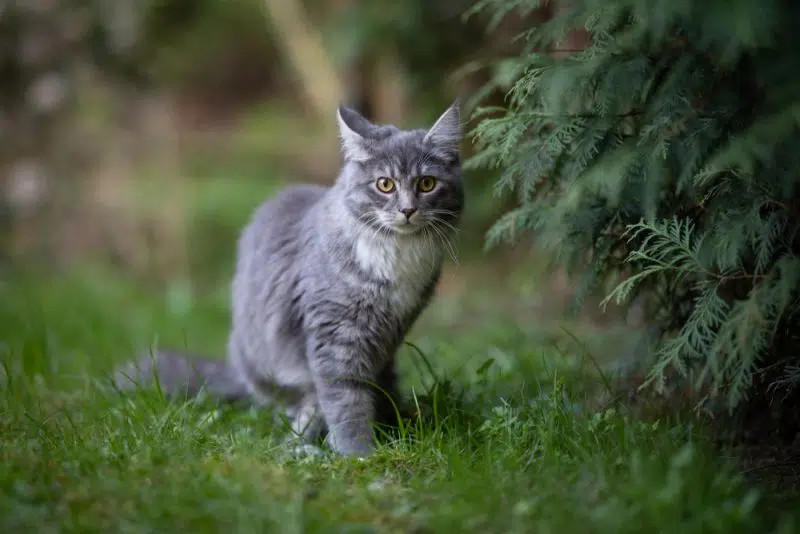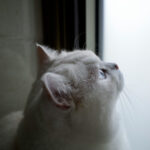Tiger Cats, often recognized by their striking stripes and the distinctive “M” marking on their forehead, are a common sight in the feline world. Yet, the term “tiger cat” can be misleading. These captivating felines aren’t a breed of their own, but rather cats displaying a specific coat pattern known as tabby. Let’s delve deeper into the world of tiger cats and uncover the fascinating facts behind this popular feline look.
Breed Overview
Height: 9–16 inches
Weight: 8–15+ pounds
Lifespan: 12–15 years
Colors: Brown, gray, orange, black, silver, red, and more.
Ideal for: Families with children, seniors, apartment living
Temperament: Varies depending on the breed
Tiger cats boast a wide array of colors and patterns, exceeding the common perception of just striped coats. While the prominent “M” marking is a hallmark, tabby patterns manifest in diverse styles, each contributing to the unique charm of these felines.
Tiger Cat Breed Characteristics
Understanding the characteristics associated with “tiger cats” requires focusing on the tabby pattern itself, as temperament and health are primarily linked to the cat’s breed rather than its coat pattern. However, we can discuss general traits relevant to active and healthy cats, which tabby cats often are.
Energy:
- Tiger cats can range from high to medium energy levels. Providing ample physical and mental stimulation is crucial for their well-being. Interactive play, scratching posts, and puzzle toys are essential to keep these intelligent cats engaged and prevent boredom. Matching a cat’s energy level to your lifestyle ensures a harmonious living environment.
Trainability:
- Many tiger cats are intelligent and trainable, especially when positive reinforcement techniques are used. Clicker training and rewarding desired behaviors with treats can be effective in teaching them tricks or commands. Early training and socialization can contribute to a well-behaved and adaptable feline companion.
Health:
- The tabby pattern itself does not predispose cats to specific health issues. However, being aware of the common health concerns within the specific breed of your tiger cat is crucial. Regular veterinary check-ups, a balanced diet, and proper exercise are fundamental for maintaining their health and longevity. Understanding potential breed-specific health risks allows for proactive care.
Lifespan:
- Like all cats, the lifespan of a tiger cat is influenced by factors such as breed, genetics, diet, lifestyle, and veterinary care. Generally, tiger cats can live for 12 to 15 years or even longer with optimal care. Providing a loving and enriching environment significantly contributes to a long and healthy life for your feline companion.
Sociability:
- Sociability in tiger cats is breed-dependent. While some breeds with tabby patterns are known for their outgoing and affectionate nature, others may be more independent. Early socialization is key to developing a well-adjusted and confident cat. Exposing them to various sights, sounds, people, and friendly animals from a young age helps them become adaptable and less fearful.
 tabby cat lying on conrete ground
tabby cat lying on conrete ground
The Historical Roots of Tiger Cats
The captivating tabby pattern has a long and rich history, dating back to the early days of domestic cats. Evidence suggests that the tabby pattern was present in domestic cats as far back as the Middle Ages.
Interestingly, the blotched tabby pattern, a variation within the tabby family, emerged as a genetic mutation during the era of the Ottoman Empire. This vast empire, which held sway over regions of Southeast Europe, West Asia, and North Africa from the 14th to the early 20th centuries, played a significant role in the spread of this pattern. Over time, the tiger cat pattern, now prevalent in nearly 80% of modern cats, gradually became more widespread throughout Southwest Asia, Africa, and Europe. However, it wasn’t until the 18th century that the tabby pattern truly became a common sight in feline populations worldwide.
The Rise in Popularity of Tiger Cats
Cats, including early tiger cats, enjoyed a revered status in ancient Egypt. These felines, likely ancestors of the tabby cats we cherish today, were highly valued for their exceptional hunting prowess. They were instrumental in controlling vermin populations in granaries, ships, and homes, thus preventing the spread of diseases.
As previously mentioned, the tabby pattern’s global prevalence didn’t solidify until the 18th century. By the late 19th century, a shift in perspective occurred in North America. Cats began to be appreciated not merely for their practical utility in rodent control but also for their companionship. By the conclusion of World War I, cats had rightfully earned their place as beloved household pets in the United States and Canada, with tiger cats being a particularly popular choice due to their striking appearance and charming personalities (inherited from their breeds).
Formal Recognition of the Tabby Pattern
It’s crucial to reiterate that “tiger cat” refers to a coat pattern, not a distinct breed. Consequently, there isn’t any formal recognition specifically for “tiger cats” as a breed. However, major cat registries like The International Cat Association (TICA) and the Cat Fanciers Association (CFA) do acknowledge and include “tabby” as a recognized coat pattern within their breed standards for numerous breeds.
For instance, TICA’s breed standard for Bengal cats includes tabby variations such as brown tabby, silver tabby, seal sepia tabby, and seal mink tabby. Similarly, the CFA breed standard for Maine Coon cats encompasses a wide spectrum of tabby colors and patterns, including classic, mackerel, and ticked tabby patterns in colors like brown, silver, red, and blue-silver, among others. This demonstrates that the beauty and diversity of the tabby pattern are celebrated within the formal cat fancy.
 blue tabby maine coon cat next to conifer tree in the back yard
blue tabby maine coon cat next to conifer tree in the back yard
Intriguing Facts About Tiger Cats
1. A Variety of Tiger Cat Patterns Exist
The quintessential image of a tabby cat often includes the prominent “M” marking on the forehead. While this is indeed a hallmark of the tabby pattern, it’s just one of several fascinating variations.
- Classic Tabby: Characterized by bold, swirling patterns on the sides of the body, often resembling a target or oyster shape.
- Mackerel Tabby: Features vertical stripes running down the sides, reminiscent of a fish skeleton, hence the name “mackerel.” Rings around the legs and tail are also typical.
- Spotted Tabby: Instead of stripes, this pattern displays spots of varying sizes across the body.
- Patched Tabby: Also known as “torbie” when combined with tortoiseshell markings, this pattern presents patches of different colors, including tabby markings intermingled with tortoiseshell or calico patches.
- Ticked Tabby: Lacks distinct stripes or spots. The tabby pattern is subtle, created by agouti hairs, where each hair has bands of different colors, resulting in a salt-and-pepper or sand-like appearance.
An infographic illustrating the diverse tabby cat patterns: Classic, Mackerel, Spotted, Ticked, and Patched.
2. The Word “Tabby” Has Historical Roots
The term “tabby” itself has an intriguing etymology. It’s believed to originate from “Attabiy,” a district in Baghdad once renowned for producing exquisite silk and striped cloths. Over time, the Middle French term “tabis” evolved into “tabis,” eventually giving rise to the modern English word “tabby.” This linguistic journey connects the striking coat pattern of tiger cats to the historical artistry of striped fabrics.
3. Legends Surround the “M” Marking
The distinctive “M” marking on the forehead of tabby cats has given rise to numerous myths and legends seeking to explain its origin.
- Egyptian Mythology: Some believe the “M” symbolizes “Mau,” the Egyptian word for “cat,” linking it to the ancient reverence for felines in Egypt.
- Christian Folklore: A heartwarming tale recounts a tabby cat comforting baby Jesus in the manger, keeping him warm. In gratitude, Mary is said to have stroked the cat’s head, leaving the “M” mark as a blessing.
- Islamic Legend: An Islamic story tells of a tabby cat named Muezza who bravely saved Prophet Mohammed from a venomous snake. As a reward, Mohammed bestowed upon cats the ability to always land on their feet. When he petted Muezza in thanks, the “M” marking miraculously appeared and remained as a symbol of gratitude and feline grace.
Are Tiger Cats Good Pets?
Absolutely! Tiger cats, or rather cats with tabby patterns, can make wonderful companions. This is because temperament is primarily determined by breed and individual personality, not solely by coat pattern. Since “tiger cat” isn’t a breed, predicting personality based on the pattern alone is impossible. A Siamese cat with a tabby point pattern will have a vastly different temperament than a laid-back Maine Coon with a classic tabby coat.
To gain insights into the potential personality of your tiger cat, it’s essential to identify their breed (or suspected breed mix if a mixed breed). Resources like breed-specific articles can offer valuable information about typical temperaments, energy levels, and care requirements associated with different breeds that commonly exhibit tabby patterns. Understanding the breed behind the pattern is key to predicting and meeting your cat’s individual needs.
 tabby with green eyes laying on a rug
tabby with green eyes laying on a rug
In Conclusion
Tiger cats are not a breed but a beautiful and diverse coat pattern found in numerous cat breeds. The tabby pattern, with its array of colors and five distinct styles, adds a touch of wild beauty to domestic felines. Understanding that “tiger cat” describes a pattern rather than a breed is crucial for appreciating the true diversity and individual personalities within the feline world. Whether you admire the classic stripes, swirling patterns, or subtle ticking, the tiger cat pattern is undeniably a captivating and enduring element of feline charm.
Featured Image Credit: Esin Deniz, Shutterstock

